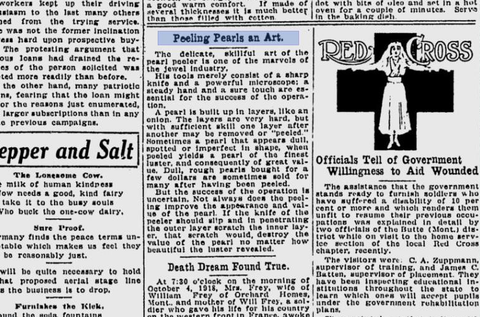Allow me to present to you this article in which our partner, M.Sc. José Manuel Nava Romo, shares an arcane art to rescue pearls with a thick coating of nacre.
A pearl is a concretion made by a mollusc to defend it against foreign objects, mainly parasites. Normally, pearls are composed of thousands of concentric layers of “mother-of-pearl”, this product being constituted mainly by Aragonite crystals (the crystalline form of calcium carbonate), the protein “conchiolin” and a little bit of water.
Some of the main characteristics of the pearl are defined -mainly- by the arrangement of its outermost nacre layers; in short, the arrangement of those last layers of nacre is what affects a pearl’s beauty.
Pearls, being formed by concentric layers, have a structure that is very similar to that of an onion, and in the same way that you can “skin” an onion is that you can remove those nacre layers.
Occasionally, some pearls may have some “poor quality” layers, so their beauty attributes are diminished: they may have spots, welts and low luster; it is for this reason that some people have sought a way to "remove" these unwanted imperfections, with the hope that by removing some outer layers those in its interior are of better quality and the pearl will look beautiful. This process is called “Pearl Peeling”.
The pearl peeling process can only be done with pearls that possess a thick mother-of-pearl coating, and this can do away with many cultured pearls; thus, this process is most suited for use in natural pearls and in very few types of cultured pearls, such as "Cortez Pearls".
The pearl peeling technique -with luck- can practically transform a valueless pearl and discover a gem quality pearl.
Nowadays, and unfortunately, due to the near disappearance of pearl oyster beds and the lower quality of many cultured pearls, there are fewer and fewer people who know, master and can utilize the pearl peeling techniques.
Below is an article that refers to the subject, published in “The Spokesman-Review” on May 20, 1919, where it says:

Peeling Pearls an Art.
The delicate, skillful art of the pearl peeler is one of the marvels of the jewel industry. His tools merely consist of a sharp knife and a powerful microscope, a steady hand and a sure touch are essential for the success of the operation. A pearl is built up in layers, like an onion. The layers are very hard, but with sufficient skill one layer after another may be removed or “peeled”.Sometimes a pearl that appears dull, spotted or imperfect in shape, when peeled yields a pearl of the finest luster, and consequently of great value. Dull, rough pearls bought for a few dollars are sometimes sold for many after having been peeled. But the success of the operation is uncertain. Not always does the peeling improve the appearance and value of the pearl. If the knife of the peeler should slip and in penetrating the outer layer scratch the inner layer, that scratch would destroy the value of the pearl no matter how beautiful the luster revealed.
The following image is a pearl in different stages of the Peeling process, where you can see it gradually “transform” into a very different pearl:

This difficult process also involves two more factors: great patience and a touch of luck; a “pearl peeler” can spend several days working with patience and delicacy, slowly removing the offending nacre layers, but “Lady Luck” is the one that will decide if all that investment will be paid: inside that worthless pearl you can either find a beauty or a beast, and you can never know in advance.

Comments (1)
Richard W Wise on July 03, 2018
Well done article on an arcane art. Love the color images.
RWW
Back to The Cortez Pearl Blog